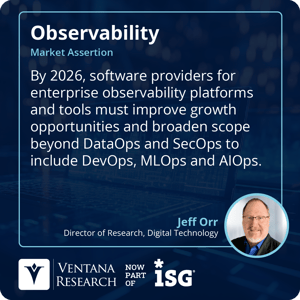Enterprises are increasingly recognizing the need to streamline operations for efficiency, agility and innovation. This has led to various “operations” or “Ops” initiatives, each focusing on a specific aspect of enterprise IT. From software development and data analytics to IT and cloud management, these Ops groups are transforming the way enterprises operate and compete.
Mergers and acquisitions, goal alignment, the addition of roles and a convergence of software technology have contributed to enterprise team structure changes, leading to a growing emphasis on specialized Ops groups. When enterprises merge or acquire others, structural changes are inevitable. These events often prompt a reevaluation of existing teams and the creation of new groups to better serve the enterprise’s goals. Team members may change roles, and new departments may form. Promotions and the addition of new roles can enhance team growth. By promoting team members and hiring new talent, enterprises can align with management initiatives and adapt to changing demands. The rise of cloud computing, intelligent automation and artificial intelligence has led to a convergence of software and services. These adjustments can lead to short-term challenges but contribute to long-term organizational effectiveness. Operations groups have emerged to optimize these areas.
Each “Ops” area is prioritized based on the enterprise’s business requirements, which must be regularly evaluated and reviewed. Examples of “Ops” areas include:
- DevOps, a software development methodology that emphasizes collaboration and communication between development and operations teams. It aims to automate the software delivery process and improve the quality of software releases. DevOps can help deliver software faster, with fewer errors, at a lower cost.
- DataOps, a methodology that aims to improve the quality and reduce the cycle time of data analytics. It emphasizes collaboration between data analysts, data engineers, data scientists and operations teams. DataOps can improve the decision-making process by providing timely and accurate data.
- ITOps, a set of practices that focuses on the day-to-day operations of IT systems. It includes tasks such as monitoring, incident management and capacity planning. ITOps can help ensure that IT systems are running smoothly and efficiently.
- CloudOps, dealing with the day-to-day operation of cloud infrastructure. It includes tasks such as provisioning, monitoring and scaling cloud resources. CloudOps ensures that cloud infrastructure is secure, reliable and cost-effective.
- NetOps, focusing on the operation of network infrastructure. It includes tasks such as network monitoring, configuration management and troubleshooting. NetOps contributes to the reliability and security of the network infrastructure.
- AIOps, an emerging field that combines artificial intelligence and machine learning with ITOps. It aims to automate IT operations tasks and improve the efficiency of IT systems. AIOps can help reduce the time and effort required to manage IT systems.
- MLOps, practices that focus on the collaborative and automated management of the end-to-end machine learning life cycle. It includes tasks such as model development, testing, deployment and monitoring. MLOps aims to streamline machine learning workflows to ensure that models are scalable, reproducible and reliable.
- SecOps, focusing on integrating security into the software development and IT operations processes. Its purpose is to improve the security of IT systems and reduce the risk of cyberattacks. SecOps can help protect the enterprise's data and reputation.
- DevSecOps, an extension of DevOps that emphasizes the integration of security into the software development process. It ensures that security is built into software from the beginning, rather than being added as an afterthought. DevSecOps can help reduce the risk of security breaches and maintain compliance with regulations.
- FinOps, a set of practices for optimizing cloud costs. It helps enterprises manage cloud spending by providing visibility into cloud usage and costs. FinOps can help reduce cloud costs and improve the efficiency of cloud operations.
- SecFinOps, an emerging field that combines security, finance and operations. It helps enterprises manage security and compliance risks while optimizing cloud costs. The goal for this team is to balance the need for security and compliance with the need to reduce cloud costs.
- ProjectOps, enhancing technology-related project delivery, resource allocation and strategic alignment with business objectives. An operations focus within the PMO can promote automation practices across project management processes, streamlining workflows.
- AnalyticOps, focusing on the operational aspects of data analytics, encompassing tasks such as data preparation, analysis automation and insight delivery. It ensures that analytical models are efficiently managed and consistently deliver actionable intelligence.
All of these categories are important. However, prioritizing different “Ops” areas depends on several factors specific to each business. For example, an enterprise that relies heavily on data analytics may prioritize DataOps, while an enterprise that develops software applications may prioritize DevOps. The demand for efficient operational groups is so strong in certain areas that we assert that by 2026, software providers for enterprise observability platforms and tools must improve growth opportunities and broaden the scope beyond DataOps and SecOps to include DevOps, MLOps and AIOps.
data analytics may prioritize DataOps, while an enterprise that develops software applications may prioritize DevOps. The demand for efficient operational groups is so strong in certain areas that we assert that by 2026, software providers for enterprise observability platforms and tools must improve growth opportunities and broaden the scope beyond DataOps and SecOps to include DevOps, MLOps and AIOps.
Some general steps an organization can follow when considering how to prioritize “Ops” initiatives include:
- Identifying business goals and objectives such as using balanced scorecards or OKRs.
- Assessing the current state with tools and frameworks including a SWOT analysis and industry benchmarking.
- Determining needs with a gap analysis framework to map gaps directly to business goals.
- Prioritizing based on impact and feasibility with a scoring system to quantify these factors.
- Developing an implementation plan of key components that considers resource allocation, timelines and risk management strategies.
- Reviewing and adjusting accordingly. A structured review process, such as PDCA (Plan-Do-Check-Act), and regular updates to the Ops strategy based on performance metrics promotes continuous improvement.
The purpose of “Ops” areas is to improve the resilience, agility, efficiency and effectiveness of IT systems, so it is important to nurture a learning-oriented environment. Once the appropriate initiatives are identified, it will be necessary to track progress. Measuring the success of “Ops” initiatives can be accomplished through quantitative and qualitative metrics. General metrics enterprises can track include:
- Efficiency: How efficiently resources are used, such as cycle time, error rates and resource utilization.
- Quality: The quality of the output, including defect density, uptime and customer satisfaction scores.
- Productivity: Measuring the output relative to the input, such as deployment frequency and lead time for changes.
- Business impact: How the “Ops” affect the business—for example, ROI, cost savings and increased revenue.
- Learning and growth: Measuring improvements in skills and capabilities, including training hours, skill upgrades and employee satisfaction.
The specific metrics used will depend on the organization’s goals and the nature of the “Ops” initiative. It is crucial to have a balanced set of metrics that cover different aspects of the initiative. This will help evaluate success from as many business perspectives as possible.
In today’s business, “Ops” initiatives have evolved beyond the realm of mere buzzwords. They have emerged as integral components of a thriving enterprise, serving as the backbone of operational efficiency and innovation. This positions enterprises to address resilience in the face of challenges, agility in response to changing market demands and sustained growth in the long run. Moreover, these “Ops” initiatives are paving the way for a future enterprise where technology and business goals are seamlessly aligned. The importance of these “Ops” areas will only continue to grow, making them an indispensable part of any successful enterprise strategy.
Regards,
Jeff Orr

 data analytics may prioritize DataOps, while an enterprise that develops software applications may prioritize DevOps. The demand for efficient operational groups is so strong in certain areas that we assert that by 2026, software providers for enterprise observability platforms and tools must improve growth opportunities and broaden the scope beyond DataOps and SecOps to include DevOps, MLOps and AIOps.
data analytics may prioritize DataOps, while an enterprise that develops software applications may prioritize DevOps. The demand for efficient operational groups is so strong in certain areas that we assert that by 2026, software providers for enterprise observability platforms and tools must improve growth opportunities and broaden the scope beyond DataOps and SecOps to include DevOps, MLOps and AIOps.








